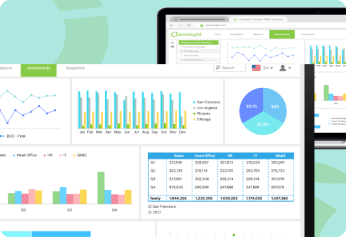Financial Planning & Analysis (FP&A) serves as the strategic backbone of modern organizations, bridging the gap between raw financial data and actionable business insights. At its core, FP&A transforms numbers into narratives that guide executive decision-making and shape company direction.
The primary goals of FP&A extend far beyond traditional number-crunching. Teams focus on creating accurate forecasts, developing comprehensive budgets, analyzing performance variances, and providing strategic recommendations that drive business growth. This function has evolved from a reactive reporting role to a proactive advisory position that influences everything from resource allocation to market expansion strategies.
In today's data-driven business environment, FP&A professionals act as financial storytellers, translating complex datasets into clear, actionable intelligence. They help organizations anticipate market changes, identify growth opportunities, and navigate financial challenges with confidence and precision.
Key Concepts in FP&A
Importance of FP&A
FP&A has become indispensable for organizations seeking sustainable growth and competitive advantage. The function directly impacts business performance by providing the analytical foundation for strategic planning and operational excellence.
The impact on business performance manifests in several ways:
- Risk Mitigation: FP&A teams identify potential financial risks before they become critical issues, allowing management to take preventive action. This proactive approach protects company resources and maintains operational stability.
- Resource Optimization: Through detailed analysis and forecasting, FP&A ensures optimal allocation of financial resources across departments, projects, and initiatives. This prevents wasteful spending while maximizing return on investment.
- Strategic Alignment: FP&A connects financial planning with business strategy, ensuring that budgets and forecasts support long-term organizational goals rather than short-term fixes.
- Performance Measurement: Regular variance analysis and KPI tracking help organizations understand what drives success and where improvements are needed, creating a culture of continuous improvement.
FP&A vs. Accounting
While both FP&A and accounting deal with financial data, their approaches, objectives, and tools differ significantly:
|
Aspect |
FP&A |
Accounting |
|
Focus |
Future-oriented planning and analysis |
Historical record-keeping and compliance |
|
Objective |
Strategic decision support |
Financial reporting accuracy |
|
Timeframe |
Forward-looking forecasts |
Past and present transactions |
|
Tools |
Planning software, modeling tools |
General ledger, accounting systems |
|
Output |
Budgets, forecasts, variance reports |
Financial statements, tax returns |
|
Audience |
Management and executives |
Investors, regulators, stakeholders |
Key Differences in Practice:
Accounting focuses on recording what happened – tracking transactions, maintaining compliance, and producing standardized financial statements. FP&A asks "what will happen?" and "what should we do about it?" This forward-looking perspective requires different skills, including scenario modeling, trend analysis, and strategic thinking.
FP&A Roles and Responsibilities
Modern FP&A teams encompass various specialized roles, each contributing unique value to organizational success:
FP&A Analyst:
- Performs detailed financial analysis and modeling
- Prepares monthly, quarterly, and annual reports
- Supports budget preparation and forecast updates
- Conducts variance analysis and identifies trends
Senior FP&A Analyst:
- Leads complex analytical projects
- Mentors junior team members
- Develops advanced financial models
- Provides insights for strategic initiatives
FP&A Manager:
- Oversees day-to-day FP&A operations
- Manages team workflows and deadlines
- Interfaces with department heads and business partners
- Ensures data quality and reporting accuracy
Director of FP&A:
- Sets strategic direction for the FP&A function
- Partners with senior leadership on major decisions
- Drives process improvements and system implementations
- Represents finance in cross-functional initiatives
VP of Finance/CFO:
- Provides executive oversight and strategic guidance
- Communicates financial insights to board and investors
- Aligns FP&A activities with overall business strategy
- Makes final decisions on major financial matters
Key Functions of FP&A Teams
FP&A teams perform several critical functions that support organizational success:
- Budgeting and Planning:Annual budget development involves collaborating with department heads to create realistic financial targets. This process includes revenue projections, expense planning, capital allocation, and scenario modeling. Teams also develop rolling forecasts that adapt to changing business conditions.
- Financial Forecasting:Regular forecast updates help organizations anticipate future performance and adjust strategies accordingly. This includes short-term cash flow projections, quarterly earnings forecasts, and long-term strategic planning models.
- Variance Analysis:Comparing actual results to budgets and forecasts reveals performance gaps and opportunities. FP&A teams investigate significant variances, identify root causes, and recommend corrective actions.
- Management Reporting:Creating clear, actionable reports for executives and department heads ensures informed decision-making. This includes executive dashboards, departmental scorecards, and ad-hoc analysis for special projects.
- Strategic Analysis:Supporting major business decisions through financial modeling and scenario analysis. This might involve evaluating new product launches, market expansion opportunities, or acquisition targets.
FP&A Tools and Technology
Modern FP&A relies on sophisticated tools that enhance efficiency and accuracy:
Traditional Tools:
- Excel: Still widely used for modeling and analysis, though limitations become apparent as organizations scale
- PowerPoint: Standard for presenting financial insights and recommendations
Cloud-Based FP&A Platforms:
- Integrated Planning Solutions: Tools like Limelight offer comprehensive FP&A capabilities with ERP integration
- Specialized Software: Platforms designed specifically for budgeting, forecasting, and financial reporting
- Business Intelligence Tools: Solutions for data visualization and self-service analytics
Key Features to Consider:
- ERP integration capabilities
- Pre-built templates and workflows
- Real-time collaboration features
- Advanced modeling and scenario planning
- Automated reporting and dashboards
- Mobile accessibility
Benefits of Modern FP&A Technology:
- Reduced manual data entry and errors
- Faster budget and forecast cycles
- Improved collaboration across teams
- Better data visualization and insights
- Scalability as organizations grow
FP&A Process
The FP&A process follows a structured approach that ensures consistency and reliability:
Step 1: Data Collection and ValidationGather financial and operational data from various sources, including ERPs, CRMs, and external databases. Validate data accuracy and completeness before analysis.
Step 2: Analysis and ModelingApply analytical techniques to identify trends, patterns, and insights. Build financial models that support decision-making and scenario planning.
Step 3: Budget and Forecast DevelopmentCreate detailed budgets and forecasts based on historical performance, market conditions, and strategic objectives.
Step 4: Review and CollaborationWork with business partners to review assumptions, validate projections, and incorporate feedback from stakeholders.
Step 5: Reporting and CommunicationPresent findings through clear, actionable reports and presentations tailored to specific audiences.
Step 6: Monitoring and UpdatesTrack actual performance against plans, identify variances, and update forecasts as needed.
FP&A Best Practices
Successful FP&A organizations follow proven best practices:
Process Optimization:
- Standardize workflows and templates
- Automate routine tasks where possible
- Establish clear timelines and deadlines
- Document procedures for consistency
Data Management:
- Maintain a single source of truth for financial data
- Implement robust data validation procedures
- Ensure proper data governance and security
- Regular data quality audits
Stakeholder Collaboration:
- Build strong relationships with business partners
- Provide training on financial concepts and tools
- Establish regular communication rhythms
- Create self-service reporting capabilities
Technology Utilization:
- Invest in appropriate tools and platforms
- Provide adequate training for team members
- Regularly evaluate and upgrade systems
- Leverage automation for efficiency gains
Continuous Improvement:
- Regularly review and refine processes
- Seek feedback from stakeholders
- Stay current with industry trends and best practices
- Invest in team development and skills building
The Future of FP&A
The FP&A landscape continues evolving rapidly, driven by technological advancement and changing business needs:
Emerging Technologies:
- Artificial Intelligence: AI-powered analytics will automate routine analysis and identify patterns humans might miss
- Machine Learning: Predictive models will become more sophisticated, improving forecast accuracy
- Robotic Process Automation: RPA will handle repetitive tasks, freeing analysts for strategic work
Changing Role of FP&A Professionals:FP&A teams are becoming more strategic, focusing on business partnering rather than just number-crunching. This shift requires developing skills in:
- Strategic thinking and business acumen
- Data science and advanced analytics
- Communication and presentation
- Change management and process improvement
Industry Trends:
- Real-time reporting and analytics
- Self-service business intelligence
- Integrated planning platforms
- Enhanced mobile capabilities
- Greater focus on ESG (Environmental, Social, Governance) metrics
FP&A Certifications and Career Path
FP&A Certifications
Professional certifications enhance credibility and career prospects in FP&A:
- Certified Management Accountant (CMA):Offered by the Institute of Management Accountants, this certification covers financial planning, analysis, control, and decision support.
- Chartered Financial Analyst (CFA):While traditionally focused on investment analysis, CFA skills are increasingly valuable in corporate FP&A roles.
- Financial Planning & Analysis (FP&A) Certificate:Specialized programs offered by universities and professional organizations focusing specifically on FP&A skills and knowledge.
- Certified Public Accountant (CPA):Provides strong foundational knowledge in accounting and finance, valuable for FP&A professionals.
Benefits of Certification:
- Enhanced credibility with employers and colleagues
- Expanded knowledge and skills
- Higher earning potential
- Professional networking opportunities
- Commitment to continuing education
Career Path in FP&A
The FP&A career path offers multiple advancement opportunities:
Entry Level (0-2 years):
- FP&A Analyst
- Financial Analyst
- Junior Business Analyst
Mid-Level (3-7 years):
- Senior FP&A Analyst
- FP&A Manager
- Business Finance Partner
Senior Level (8-15 years):
- Director of FP&A
- Senior Finance Manager
- VP of Finance
Executive Level (15+ years):
- Chief Financial Officer (CFO)
- Chief Operating Officer (COO)
- General Manager
Essential Skills for Advancement:
Technical Skills:
- Advanced Excel and financial modeling
- ERP systems knowledge
- Business intelligence tools
- Statistical analysis and forecasting
Business Skills:
- Strategic thinking and planning
- Industry knowledge and market awareness
- Project management
- Process improvement
Soft Skills:
- Communication and presentation
- Leadership and team management
- Problem-solving and critical thinking
- Relationship building and collaboration
Streamline Your FP&A Operations with Modern Solutions
As organizations continue to scale and face increasing complexity, the limitations of traditional spreadsheet-based FP&A become more apparent. Finance teams spending countless hours on manual data consolidation, error checking, and version control find themselves reactive rather than strategic.
Modern FP&A platforms address these challenges by providing integrated solutions that connect directly with your existing ERP and accounting systems. With pre-built templates, intuitive modeling capabilities, and automated reporting, teams can focus on analysis and insights rather than data management.
Want to see it in action? Book a demo and experience how Limelight can streamline your planning and forecasting from end to end.
Table of Contents
Ready to put an end to outdated FP&A?
Get a perzonalized demo


